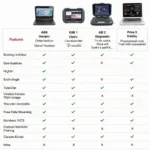The BMW X1 OBD2 port is your gateway to understanding your vehicle’s health and performance. This article provides a comprehensive guide to locating, using, and understanding the OBD2 port on your BMW X1, equipping you with the knowledge to perform diagnostics, monitor performance, and enhance your driving experience.
Understanding the OBD2 Port on Your BMW X1
The OBD2 port, officially known as the On-Board Diagnostics port, is a standardized 16-pin connector found in most vehicles manufactured after 1996, including all BMW X1 models. It’s the primary interface for connecting diagnostic tools, code readers, and other OBD2 devices to access your vehicle’s computer system. This port allows you to read diagnostic trouble codes (DTCs), monitor real-time data, and perform various tests.
Knowing the location of your BMW X1’s OBD2 port is crucial for DIY diagnostics and maintenance. For most X1 models, the port is located under the dashboard, on the driver’s side, near the steering column. However, the exact location may vary slightly depending on the model year. If you’re having trouble locating it, consult your owner’s manual.
Why is the BMW X1 OBD2 Port Important?
The OBD2 port offers a wealth of information, enabling you to:
- Diagnose problems: Read and interpret DTCs to identify the root cause of warning lights or performance issues.
- Monitor performance: Track real-time data such as engine speed, coolant temperature, and fuel economy.
- Customize settings: Some OBD2 devices allow you to adjust certain vehicle parameters.
- Enhance your driving experience: Use OBD2 data to improve fuel efficiency, monitor driving habits, and gain insights into your vehicle’s performance.
You can even use it to display your digital speedometer with certain OBD2 devices, as discussed on our bmw x1 use obd2 to show digital speed0meter page.
Common Uses for the BMW X1 OBD2 Port
There are numerous ways to utilize the OBD2 port on your BMW X1. Here are some common scenarios:
- Checking Engine Light: If your check engine light illuminates, connecting an OBD2 scanner will reveal the corresponding DTC, providing valuable information for troubleshooting.
- Emissions Testing: The OBD2 port is used during emissions inspections to verify that your vehicle meets environmental regulations.
- Performance Monitoring: Enthusiasts and professionals can use OBD2 data to analyze vehicle performance and identify areas for improvement.
- Insurance Telematics: Some insurance companies offer programs that utilize OBD2 data to monitor driving habits and offer discounts based on safe driving practices.
“Regularly checking your BMW X1’s OBD2 port with a reliable scanner can save you money on costly repairs by catching potential problems early,” says automotive expert, Michael Stevenson, ASE Certified Master Technician.
What Can an OBD2 Scanner Tell You About Your BMW X1?
An OBD2 scanner can provide a wealth of information about your BMW X1, ranging from simple diagnostic trouble codes to complex performance data. This information can help you understand your vehicle’s health, identify potential problems, and make informed decisions about maintenance and repairs.
Choosing the Right OBD2 Scanner for Your BMW X1
With a multitude of OBD2 scanners available, selecting the appropriate device can be daunting. Consider the following factors when making your choice:
- Compatibility: Ensure the scanner is compatible with your BMW X1’s model year and specific systems.
- Features: Determine the features you require, such as code reading, data logging, and live data streaming.
- Budget: OBD2 scanners range in price from basic code readers to advanced professional-grade tools.
- User-friendliness: Choose a scanner with a clear and easy-to-navigate interface.
For instance, if you’re looking for a digital speedometer display, checking our resource on obd2 digital speedo can be helpful. For older models, knowing the obd2 connector location bmw x1 2013 specifically can save you time.
“Investing in a quality OBD2 scanner is a smart move for any BMW X1 owner. It empowers you to take control of your vehicle’s maintenance and stay ahead of potential problems,” advises Sarah Johnson, Automotive Engineer and OBD2 specialist. You can even find out where is the obd2 on a 2015 bmw x1.
Conclusion
The bmw x1 obd2 port is a valuable tool for understanding and maintaining your vehicle. By utilizing this port with the right OBD2 scanner, you can diagnose problems, monitor performance, and gain valuable insights into your BMW X1’s overall health.
Need support? Contact us via WhatsApp: +1(641)206-8880, Email: [email protected] or visit us at 789 Elm Street, San Francisco, CA 94102, USA. Our customer service team is available 24/7.

